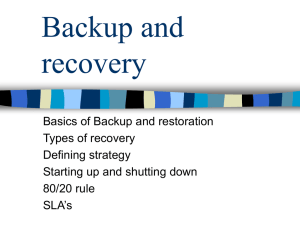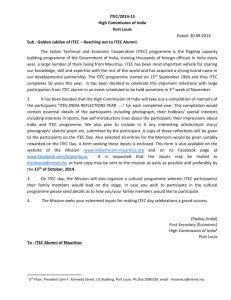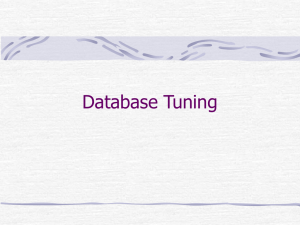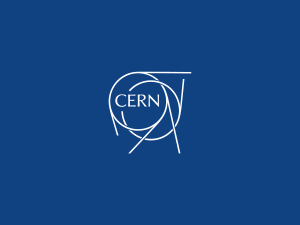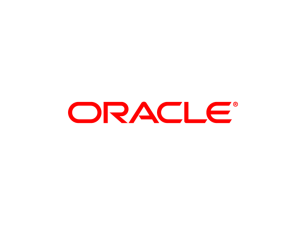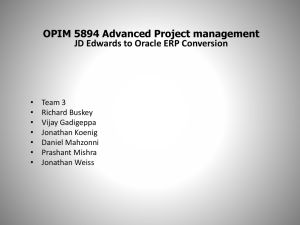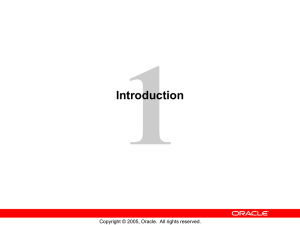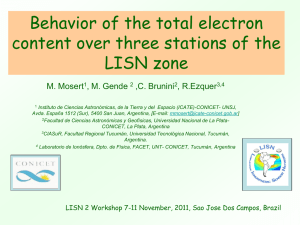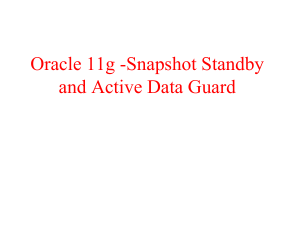Introduction of Week 2
advertisement
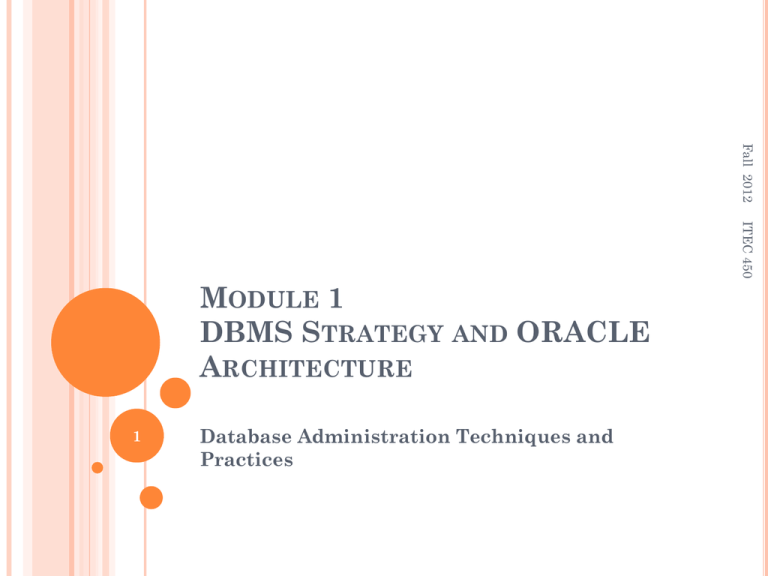
Fall 2012 ITEC 450 MODULE 1 DBMS STRATEGY AND ORACLE ARCHITECTURE 1 Database Administration Techniques and Practices ORGANIZATION’S DBMS STRATEGY ITEC 450 It’s typical to run two or more DBMS products in large and medium-sized organization The organization should have the vision to consolidate and minimize the number Using an existing DBMS whenever it is possible Once a DBMS is installed, removal can be difficult: incompatibilities, conversion, special features Organization’s DBMS strategy is a join effort from groups of DBA, Architect, App Dev, and Business Fall 2012 2 CHOOSING A DBMS: SELECTION DRIVERS A commercial off-the-shelf application package: ERM, PeopleSoft, CRM The latest and greatest technology: Web, Java, .NET DBMS performance: TPC benchmarks Operating systems: Unix, Windows, Linux Hardware platforms: HP, Sun, IBM, Dell Total cost of ownership: license, people, development, and maintenance support ITEC 450 Fall 2012 3 LEVELS OF DBMS ARCHITECTURE Enterprise and Departmental DBMS Scalability and availability, high performance Large database, concurrent users, multiprocessors Examples: Oracle, DB2, SQL Server ITEC 450 Fall 2012 Personal DBMS: Access, Visual dBase, Personal Oracle Mobile DBMS: a special version of DBMS for remote users who are not on the network all the time. 4 DBMS ARCHITECTURE COMPONENTS Disk: logical and physical database structures CPU: Operating system processes Memory: shared and private memory structures Network: user access and process interactions Clustering: multiple computing systems working together ITEC 450 Fall 2012 5 SECTION IMPORTANT NOTES This section is Oracle specific. Terms can be very different among different DBMS’s (e.g. Oracle vs. SQL) ITEC 450 Fall 2012 Database (different) Instances (different) Schemas (common) Segments (Oracle specific) 6 ORACLE DATABASE AND INSTANCE Fall 2012 An Oracle Database server consists of an Oracle Database and one or more Oracle Database instances. Database: all Oracle related files ITEC 450 Data files – holding tables and indexes System files – System, Undo, Temp Physical and logical structures Instance: the combination of processes and memory Processes – background Memory – allocated to Oracle Running components – Instance is up 7 Fall 2012 ORACLE DATABASE AND ITEC 450 INSTANCE 8 PHYSICAL DATABASE STRUCTURE Main types of files – data files, control files, redo log files, archived redo log files. Data files – database data, such as tables and indexes Control files – Oracle structure information, such as database name, data file names, time stamp of database Redo log files – database change logs for recovery Archived redo log files – offline copies of online redo log files ITEC 450 Fall 2012 Parameter files – SPFILE, init.ora Administration files – alert.log, trace files, the password files 9 PHYSICAL DATABASE STRUCTURE Fall 2012 ITEC 450 10 LOGICAL STRUCTURE DETAILS Fall 2012 ITEC 450 Read Chapter 2 Oracle Database Concept Data block - the standard block size is determined by the init parameter DB_BLOCK_SIZE. Extent - When you create a database object, you allocate it an initial extent. When the object grows more than the initial extent, Oracle will automatically allocate next extent. Segment - Oracle calls all the space allocated to a particular database object a segment, such as table or index. Tablespace - A tablespace contains one or more physical files; a data file belongs to one and only one tablespace. 11 LOGICAL & PHYSICAL DATABASE STRUCTURE Fall 2012 ITEC 450 12 ONLINE REDO LOG FILES AND ARCHIVE LOG FILES Redo log files record changes to database data ITEC 450 Online redo log files are open and available whenever the database is up and running They capture details of DB transactions and information about changes to DB including: Fall 2012 Checkpoints Changes Data Manipulation Language (DML) Data Definition Language (DDL) Datafile changes A database should have at least three redo log groups containing at least one file each 13 ONLINE REDO LOG FILES AND ARCHIVE LOG FILES Fall 2012 ITEC 450 14 PURPOSE OF REDO LOG FILES Purpose: aid in database recovery ITEC 450 Redo log files keep list of DB changes If DB loses changes, recovery process restores them Redo log files receive the change information before the data files are updated In minor failures (e.g., short power outage), redo log files are automatically checked during DB startup, and data is restored, from redo log files into data files In major failures (e.g., loss of an entire disk), data would not be saved from the online redo logs alone Fall 2012 You need a full DB backup and archived redo log files that begin after the date of the backup 15 STRUCTURE OF REDO LOG FILES Redo log files store info as a result of DB activity Contents of redo log buffer are written by LGWR process, to online redo log file, when: A transaction issues a COMMIT command Redo log buffer is one-third full Every 3 seconds A checkpoint occurs ITEC 450 Information is recorded in the redo log buffer in SGA Fall 2012 The redo log file contains sets of redo records A redo record (or redo entry) is made up of a related group of change vectors that record a description of the changes to a single block in the DB A single transaction may generate many redo entries 16 REDO LOG MANAGEMENT Fall 2012 ITEC 450 17 ORACLE DATABASE STRUCTURE Fall 2012 ITEC 450 18 OVERVIEW OF ORACLE INSTANCE Fall 2012 ITEC 450 When a database is started, Oracle starts many background processes and acquires memory structures. The combination of the background processes and memory buffers is called an Oracle instance. 19 ORACLE PROCESSES ITEC 450 Fall 2012 Read Chapter 9 Oracle Database Concept A process is a connection or thread to the operating system. Oracle processes – server processes and background processes. The background processes are the core of the Oracle instance. When you start an instance, these processes are created; when you shutdown an instance, these processes are terminated. Database writer Log writer Process monitor System monitor User processes – connecting users to the database instance 20 ORACLE PROCESSES ITEC 450 Database Writer (DBW0): Database writer process uses a leastrecently-used (LRU) algorithm to identify dirty buffers and write them to disk. Dirty buffers are buffers that contain data that has been modified Log Writer (LGWR): The log writer process is responsible for writing the redo entries from the redo log buffer to the disk files. Check Point (CKPT): The check point process performs check point on an on-going basis. Check point flushes all the buffers from the buffer cache to the disk and also all the current redo log sequence number and time stamps are written to the all of the data files. Process Monitor (PMON): The process monitor monitors all server processes. When ever a user connection fails, PMON is responsible foe cleaning up the buffer cache and freeing up system resources used by the failed process. System Monitor (SMON): The system monitor is involved in instance recovery when the database is started. Fall 2012 21 ORACLE MEMORY STRUCTURES Fall 2012 ITEC 450 Read Chapter 8 Oracle Database Concept The memory structures enable Oracle to share executable code, and produces high performance. Oracle uses two basic memory structures: shared and process-specific System global area (SGA) – total memory shared by all server processes including background processes Program global area (PGA) – memory used for private (application, program) processes 22 SYSTEM GLOBAL AREA ITEC 450 Fall 2012 The SGA main components. Database buffer cache – recently used blocks of data Shared pool – library cache, data dictionary cache Redo log buffer – a log of database changes Other Memory areas: Large pool – optional large memory segments for shared SQL and better performance Java pool – memory for java code and data within the JVM Streams pool – memory for using Streams Automatic shared memory management: total amount of SGA memory for the database 23 DATABASE BUFFER CACHE Fall 2012 ITEC 450 Used to hold data blocks read from datafiles by server processes Contains ‘dirty’ or modified blocks and ‘clean’ or unused or unchanged bocks ‘Dirty’ and ‘clean’ blocks are managed in lists called the dirty list and the LRU Free space is created by DBWR writing out ‘dirty’ blocks or aging out blocks from the LRU Size is managed by the parameter DB_BLOCK_BUFFERS 24 REDO LOG BUFFER A circular buffer that contains redo entries Redo entries reflect changes made to the database ITEC 450 Redo entries take up contiguous, sequential space in the buffer Data stored in the redo log buffer is periodically written to the online redo log files Size is managed by the parameter LOG_BUFFER Fall 2012 Default is 4 times the maximum data block size for the operating system 25 SHARED POOL Consists of multiple smaller memory areas Library cache Shared SQL area Contains parsed SQL and execution plans for statements already run against the database ITEC 450 Fall 2012 Procedure and package storage Dictionary cache Names of all tables and views in the database Names and datatypes of columns in the database tables Privileges of all users Managed via an LRU algorithm Size determined by the parameter SHARED_POOL_SIZE 26 PROGRAM GLOBAL AREA ITEC 450 Program Global Area (PGA) Effectively used in session connection memory Broken into private chunks for each server process Fall 2012 It is a non shared memory created by Oracle when a server process is started. Access to it is exclusive to that server process and is read and written only by Oracle code acting on behalf of it. The total PGA memory allocated by each server process attached to an Oracle instance is also referred to as the aggregated PGA memory allocated by the instance. 27 SGA & BACKGROUND PROCESSES Fall 2012 ITEC 450 28 BACKGROUND PROCESSES (CONTINUED) Fall 2012 ITEC 450 29 DATABASE Oracle defines a DB as the collection of operating system files that store your data ITEC 450 Install the software components, create DB files to store your data, and start a set of background processes that allocate memory and handle database activities Fall 2012 Database server: combination of DB software, a DB (the files), and DB instance (the SGA and the background processes) Single-instance server (typical configuration) Multiple-instance server Clustered servers 30 SINGLE INSTANCE SERVER Fall 2012 ITEC 450 31 MULTI INSTANCE SERVER Fall 2012 ITEC 450 32 CLUSTERED SERVER Fall 2012 ITEC 450 33 ORACLE SOFTWARE OPTIONS Enterprise Edition: includes all major components Standard Edition: provides basic support for multi-user database applications on a smaller scale than that of the Enterprise Edition ITEC 450 Enables multiple users to connect concurrently Optimized for high data volume is common Supports multiple DB instances and replication Fall 2012 Cannot be upgraded with database features Personal Edition: single-user access to DB instance Two primary uses: programming and deployment 34 ORACLE SOFTWARE SOME ADDITONAL OPTIONS Optional features requiring additional license fees: ITEC 450 Oracle Partitioning Oracle Cluster ware Oracle Spatial Oracle Data Mining Oracle Database Extensions for .NET Oracle Advanced Security And Other.. Fall 2012 Note: Some of the slides are from Oracle 10g Database Administrator: Implementation and Administration by Gavin Powell and Carol McCullough-Dieter 35
